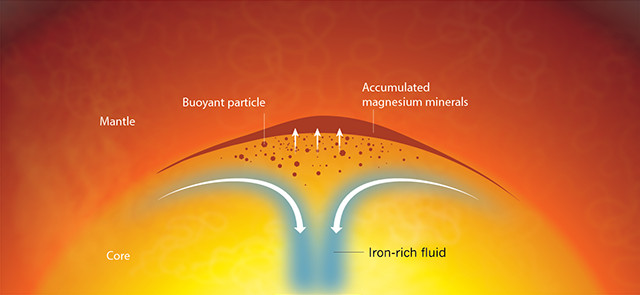
by Lucas Joel Tuesday, April 19, 2016

An artist's interpretation of how the precipitation of buoyant magnesium-bearing minerals, which rise toward the core-mantle boundary, from the otherwise iron-rich core could drive compositional convection and help drive Earth's geodynamo. Credit: reprinted from Nature with permission.
Earth’s magnetic field, which arises from convective flows in the planet’s core, known as the geodynamo, has existed for at least 3.4 billion years, meaning that the field-generating processes must have existed for that long as well. But what exactly those processes have looked like throughout Earth’s history, particularly early on, has been poorly understood. In a new study, researchers suggest that magnesium mineral formation in the core is a previously unrecognized but important piece of the puzzle.
The core is about 90 percent iron and nickel, and is divided into a solid inner and a liquid outer core. Cooling of the core since Earth’s initial formation (and perhaps decay of radioactive elements in the core) is thought to have partially powered the geodynamo through thermal convection. Meanwhile, solidification of heavy elements like iron, which fall toward the inner core and drive compositional convective flows, may have also contributed.
But recent studies have suggested that iron in the core may be more th"rmally conductive than previously thought — meaning it can transmit heat out of the core more efficiently — and that the inner core probably did not form before 1 billion years ago. “If the core can lose heat [via conduction through iron], it will, and the heat will just come out of the core without driving any [convective] fluid motions,” says Joseph O’Rourke, a doctoral student studying planetary sciences at Caltech and lead author of th" new study, published in Nature. Without the compositional convection driven by solidification of iron into the inner core, thermal convection due to cooling is left as the main mechanism for powering the geodynamo, which creates problems for conventional models of how the core operates.
Before the recent finding that iron has higher thermal conductivity, “it wasn’t really a challenge to sustain the geodynamo” in models over most of Earth’s history, says Bruce Buffett, a planetary scientist at the University of California at Berkeley who was not involved in the new work but who wrote a commentary, also in Nature, on the new study. But with such high thermal conductivities for iron suggesting a much-delayed formation of the inner core, it creates a challenge, Buffett says. “It sets the threshold that has to be reached, in terms of cooling rates [in the core], much higher before convection actually turns on,” implying that some other process besides thermal convection must have been fueling the geodynamo.
In the new work, O’Rourke and his co-author David Stevenson, also at Caltech, have “found a way to keep the geodynamo goin” before the solid inner core existed," O’Rourke says. The answer, it seems, lies early in Earth’s history, when the planet was still forming. “The last stages of Earth’s formation involved these really violent giant impacts … and during those impacts the mantle would have been heated to thousands of degrees above its melting temperature,” O’Rourke says. These high temperatures, he says, would have allowed magnesium from silicate magma, which is typically insoluble in iron, to dissolve in the core. As the core then cooled, buoyant magnesium-bearing minerals would precipitate from the remaining dense, iron-rich magma and move up toward the core-mantle boundary; this separation process could drive convective flow.
There is still a lot we don’t understand about Earth when it was being bombarded by and mixing with other large bodies, Buffett says. But the new model captures “key issues” and is an important contribution to advancing our understanding of the core, he says.
Understanding how the geodynamo has functioned throughout Earth’s history may help explain how geodynamos once functioned on our neighboring planets — or still do function in the case of Mercury, Buffett says. “Once we better understand how magnesium dissolves in iron, and how much energy we are likely to get from that [process], we can then apply the same ideas to other planets like Venus, Mars or Mercury.” The new knowledge, he adds, could also be applied to exoplanets beyond our solar system such as super-Earths.
© 2008-2021. All rights reserved. Any copying, redistribution or retransmission of any of the contents of this service without the expressed written permission of the American Geosciences Institute is expressly prohibited. Click here for all copyright requests.